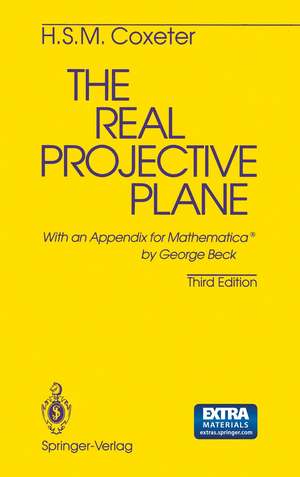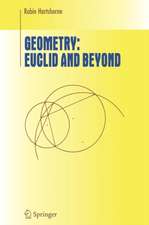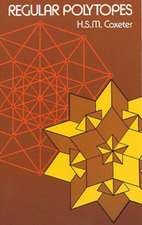The Real Projective Plane
Apendix de G. Beck Autor H.S.M. Coxeteren Limba Engleză Paperback – 8 aug 2013
| Toate formatele și edițiile | Preț | Express |
|---|---|---|
| Paperback (2) | 384.86 lei 6-8 săpt. | |
| Springer – 8 aug 2013 | 384.86 lei 6-8 săpt. | |
| Springer – 2 oct 2011 | 468.44 lei 6-8 săpt. | |
| Mixed media product (1) | 532.15 lei 6-8 săpt. | |
| Springer – 23 dec 1992 | 532.15 lei 6-8 săpt. |
Preț: 384.86 lei
Nou
Puncte Express: 577
Preț estimativ în valută:
73.65€ • 77.24$ • 61.31£
73.65€ • 77.24$ • 61.31£
Carte tipărită la comandă
Livrare economică 01-15 aprilie
Preluare comenzi: 021 569.72.76
Specificații
ISBN-13: 9781461392835
ISBN-10: 1461392837
Pagini: 240
Ilustrații: XIV, 222 p.
Dimensiuni: 155 x 235 x 13 mm
Greutate: 0.34 kg
Ediția:3rd ed. 1993. Softcover reprint of the original 3rd ed. 1993
Editura: Springer
Colecția Springer
Locul publicării:New York, NY, United States
ISBN-10: 1461392837
Pagini: 240
Ilustrații: XIV, 222 p.
Dimensiuni: 155 x 235 x 13 mm
Greutate: 0.34 kg
Ediția:3rd ed. 1993. Softcover reprint of the original 3rd ed. 1993
Editura: Springer
Colecția Springer
Locul publicării:New York, NY, United States
Public țintă
GraduateCuprins
1. A Comparison of Various Kinds of Geometry.- 1·1 Introduction.- 1·2 Parallel projection.- 1·3 Central projection.- 1·4 The line at infinity.- 1·5 Desargues’s two-triangle theorem.- 1·6 The directed angle, or cross.- 1·7 Hexagramma mysticum.- 1·8 An outline of subsequent work.- 2. Incidence.- 2·1 Primitive concepts.- 2·2 The axioms of incidence.- 2·3 The principle of duality.- 2·4 Quadrangle and quadrilateral.- 2·5 Harmonic conjugacy.- 2·6 Ranges and pencils.- 2·7 Perspectivity.- 2·8 The invariance and symmetry of the harmonic relation.- 3. Order and Continuity.- 3·1 The axioms of order.- 3·2 Segment and interval.- 3·3 Sense.- 3·4 Ordered correspondence.- 3·5 Continuity.- 3·6 Invariant points.- 3·7 Order in a pencil.- 3·8 The four regions determined by a triangle.- 4. One-Dimensional Projectivities.- 4·1 Projectivity.- 4·2 The fundamental theorem of projective geometry.- 4·3 Pappus’s theorem.- 4·4 Classification of projectivities.- 4·5 Periodic projectivities.- 4·6 Involution.- 4·7 Quadrangular set of six points.- 4·8 Projective pencils.- 5. Two-Dimensional Projectivities.- 5·1 Collineation.- 5·2 Perspective collineation.- 5·3 Involutory collineation.- 5·4 Correlation.- 5·5 Polarity.- 5·6 Polar and self-polar triangles.- 5·7 The self-polarity of the Desargues configuration.- 5·8 Pencil and range of polarities.- 5·9 Degenerate polarities.- 6. Conics.- 6·1 Historial remarks.- 6·2 Elliptic and hyperbolic polarities.- 6·3 How a hyperbolic polarity determines a conic.- 6·4 Conjugate points and conjugate lines.- 6·5 Two possible definitions for a conic.- 6·6 Construction for the conic through five given points.- 6·7 Two triangles inscribed in a conic.- 6·8 Pencils of conics.- 7. Projectivities on a Conic.- 7·1 Generalizedperspectivity.- 7·2 Pascal and Brianchon.- 7·3 Construction for a projectivity on a conic.- 7·4 Construction for the invariant points of a given hyperbolic projectivity.- 7·5 Involution on a conic.- 7·6 A generalization of Steiner’s construction.- 7·7 Trilinear polarity.- 8. Affine Geometry.- 8·1 Parallelism.- 8·2 Intermediacy.- 8·3 Congruence.- 8·4 Distance.- 8·5 Translation and dilatation.- 8·6 Area.- 8·7 Classification of conics.- 8·8 Conjugate diameters.- 8·9 Asymptotes.- 8·10 Affine transformations and the Erlangen programme.- 9. Euclidean Geometry.- 9·1 Perpendicularity.- 9·2 Circles.- 9·3 Axes of a conic.- 9·4 Congruent segments.- 9·5 Congruent angles.- 9·6 Congruent transformations.- 9·7 Foci.- 9·8 Directrices.- 10. Continuity.- 10·1 An improved axiom of continuity.- 10·2 Proving Archimedes’ axiom.- 10·3 Proving the line to be perfect.- 10·4 The fundamental theorem of projective geometry.- 10·5 Proving Dedekind’s axiom.- 10·6 Enriques’s theorem.- 11. The Introduction of Coordinates.- 11·1 Addition of points.- 11·2 Multiplication of points.- 11·3 Rational points.- 11·4 Projectivities.- 11·5 The one-dimensional continuum.- 11·6 Homogeneous coordinates.- 11·7 Proof that a line has a linear equation.- 11·8 Line coordinates.- 12. The Use of Coordinates.- 12·1 Consistency and categoricalness.- 12·2 Analytic geometry.- 12·3 Verifying the axioms of incidence.- 12·4 Verifying the axioms of order and continuity.- 12·5 The general collineation.- 12·6 The general polarity.- 12·7 Conics.- 12·8 The affine plane: affine and areal coordinates.- 12·9 The Euclidean plane: Cartesian and trilinear coordinates.- Appendix 1. The Complex Projective Plane.- Appendix 2. How to Use Mathematica® by George Beck.






















